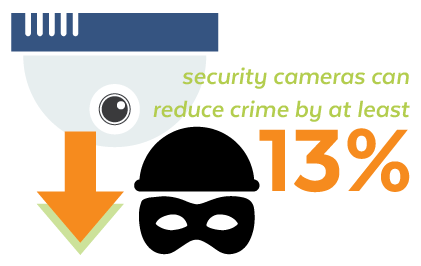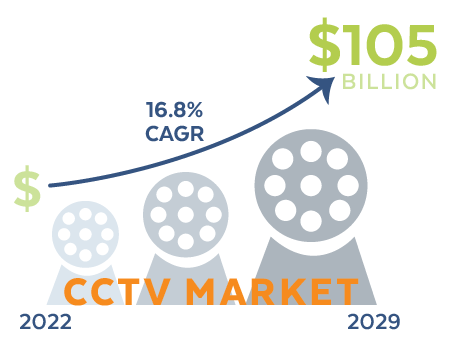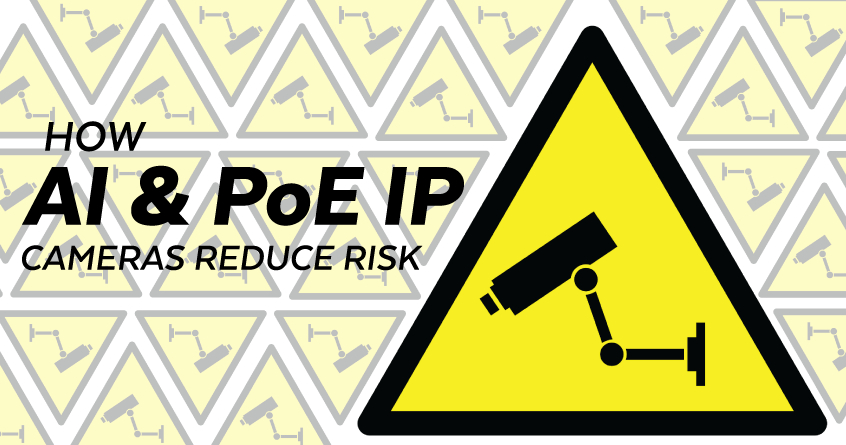It should be no surprise that safety is the second tier of Maslow’s pyramid of needs. After meeting the most basic survival needs such as food, water, and air, humans instinctively seek out safety. We all desire physical, emotional, and financial security to feel some semblance of peace in our world. By achieving a basic level of safety, communities can thrive. High-crime areas rarely attract people or businesses. Few institutions would want to invest resources in unsafe cities. This is exactly why community leaders are looking at new technologies, such as AI and PoE, to help build safer cities with limited budgets. 
More communities are turning to digital technologies to reduce crime. Although surveillance systems have been used for years, recent studies have found that security cameras can reduce crime by at least 13%. Cameras can reduce drug-related crime by 20% and property or vehicle crime by 23%. However, large surveillance systems capture vast amounts of data, and this makes real-time monitoring difficult. They can also be expensive to install and maintain.
Adding artificial intelligence (AI) to existing safety infrastructures enables metropolitan areas to process captured images in real time. Without AI, monitoring London’s 800,000 cameras, for example, would be impossible. Not only do AI-based systems process data more quickly, they can also send automated alerts to first responders for better response times. Capitalizing on power over Ethernet (PoE) allows local governments to place IP cameras where they are most needed.
Community Safety in the 21st Century
The global CCTV camera market is expected to reach over $105 billion by 2029, with a compound annual growth rate (CAGR) of 16.8% between 2022 and 2029. Much of that anticipated growth is related to the increase in the use of AI-based solutions for enhanced security protection. Despite this increase, surveillance systems will still have their limitations.
 Cost
Cost
Comprehensive camera placement can exceed small municipality budgets. Rural communities may need to cover thinly populated areas. Paying for hours of surveillance with minimal activity can stretch a town’s resources. AI solutions may simply be beyond their means.
False Alarms
AI isn’t perfect and images can be misinterpreted. Depending on camera angles or weather conditions, a package handoff could appear to be a robbery in progress. If cameras are not placed correctly, first responders could be dispatched unnecessarily. This wastes time and resources.
Inadequate Coverage
Providing surveillance of every square inch of a community is virtually impossible. Cost is a factor. Placing cameras in remote locations may be cost-prohibitive if power sources are limited.
Poor Lighting
Not every camera can operate in low-lighting conditions. Poor contrast can make it difficult to interpret captured footage. Without clear images, identification of individuals involved in illegal activity can be challenging.
Human Error
Whether AI- or human-based, surveillance systems can produce errors. Technology is not the only cause of false positives. Humans can misinterpret images too. More often though, it is the sheer volume of data being captured that poses a challenge for human operators. They are forced to make split-second judgments with little data.
No Predictive Capabilities
Surveillance cameras record what is or has happened. They can’t predict what might happen. AI-based solutions use sophisticated algorithms to predict where crimes may occur. AI can identify shared characteristics of high-crime areas based on hours of analyzed video footage.
Many of the above constraints can be addressed by combining AI solutions with PoE technology.
Improving Community Safety with AI and PoE
By combining AI and PoE technologies, municipalities can create a smart and cost-effective IP-based surveillance solution for improving public safety. When IP cameras were first introduced, they offered the same image resolution as VGA (640×480 pixels). Low-light capabilities did not exist. By 2009, cameras could record video in high-definition. Today’s cameras can operate in low-light conditions and at increased ranges.
PoE and IP Cameras
PoE technology delivers data and power over a single Ethernet cable simultaneously, eliminating the need for a separate power source. Most modern IP cameras now come with built-in support for PoE. PoE technology can also be added to a non-PoE-capable device using a PoE splitter. Although PoE is often used in power-unavailable locations, it can also be used in other environments, such as:
- Buildings where codes require additional AC power cables.
- Technologies where high data transfer rates are needed.
- Deployments where variances in power standards impact reliability.
The latest IEEE PoE standard provides up to 90W of power with data transfer rates of a gigabit or higher. These capabilities support higher-resolution images, making it easier to identify potential suspects and providing improved evidentiary tools.
AI and IP Cameras
AI capabilities are already being incorporated into surveillance systems. While AI’s ability to process volumes of data for real-time alerts improves response times, its predictive capabilities make for safer communities. Faster responses to crimes in progress can reduce severity, but preventing crime enhances security overall.
Smart IP cameras learn from experience and adapt to changing patterns. AI can detect anomalies and potential threats. For example, AI may identify a delivery vehicle operating in the same vicinity at the same time over a four-week period. Because the vehicle only appears once a week, humans may not see the pattern. AI can highlight the behavior and bring it to the attention of security personnel so they can determine if it is a legitimate delivery route or a criminal conducting surveillance and planning for a future crime.
Building a Safer Future
Local governments are responsible for securing their communities, whether on public streets or in public schools. More municipalities are looking at AI-capable solutions that can deliver advanced analytics and predictive modeling. They are also searching for more cost-effective solutions. The need for improved surveillance at a reasonable cost has more governments looking at:
- Cloud-based surveillance platforms that deliver video surveillance as a service (VSaaS) for a fee.
- Cloud-based storage for video surveillance footage and AI-based analytics.
- Competitively priced IP cameras.
- PoE technology for lower life-cycle costs.
A feeling of physical safety is fundamental to survival. A 2023 report on safety perceptions found an increase in the number of people worried about violent crime. That increase does not bode well for communities that lack the tools to ensure public safety. As technology advances, local governments can turn to cost-effective AI-and PoE-enabled surveillance systems to improve the public’s perception of safety. As a supplier of PoE technology, Versatek offers solutions that deliver the latest advances in technology at a reasonable price.

